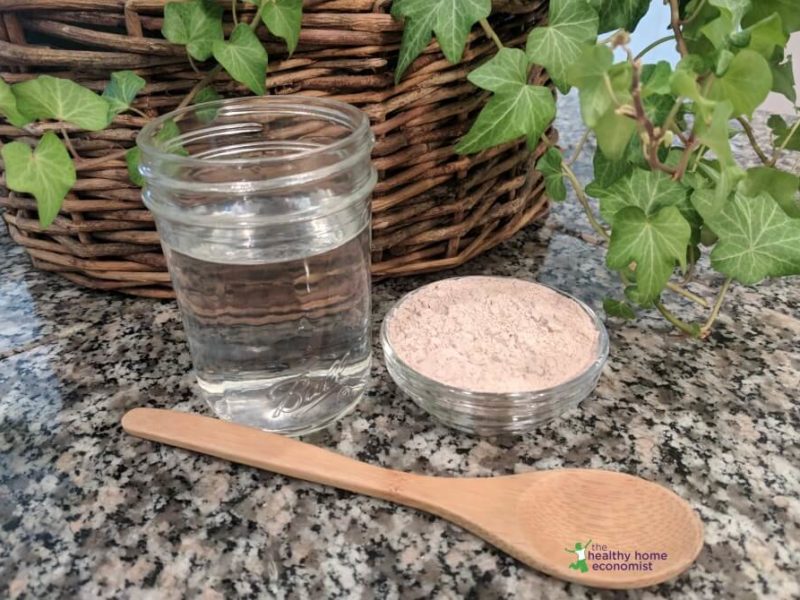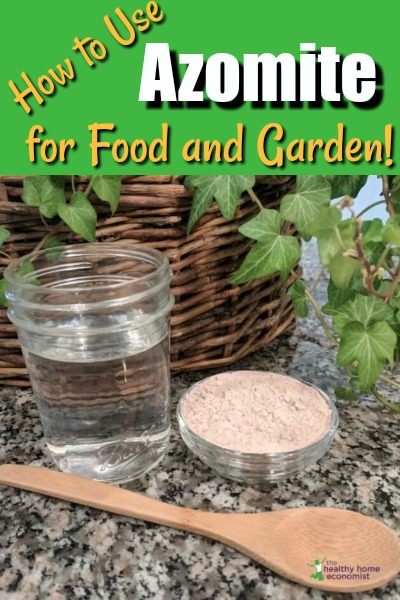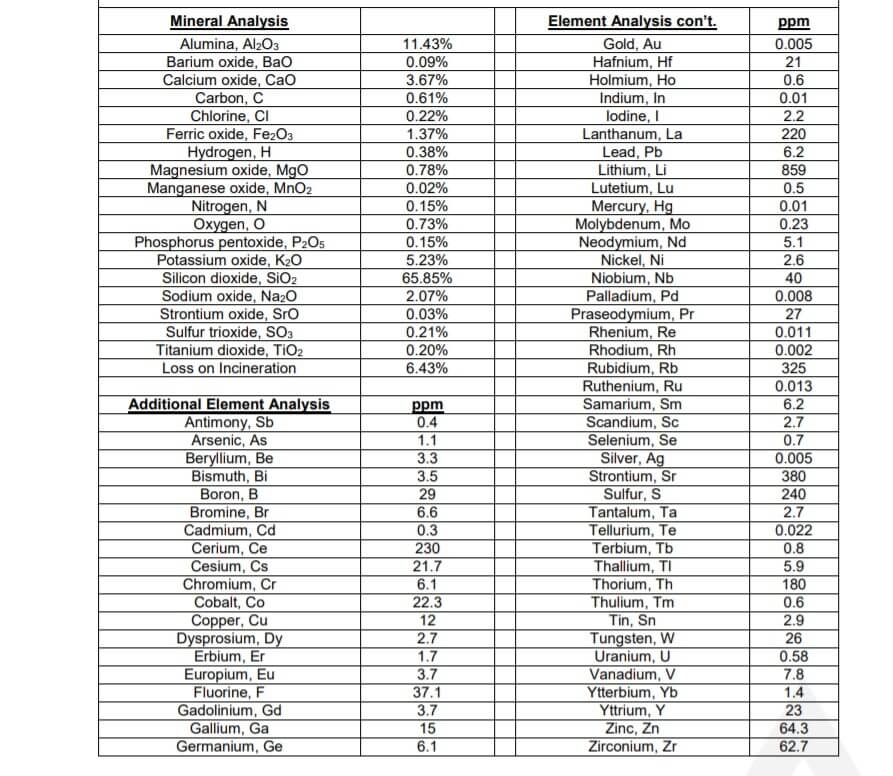Table of Contents[Hide][Show]

Azomite is one of those beneficial substances that is useful for many things around the home. It belongs in the same category as apple cider vinegar, diatomaceous earth, and baking soda.
For this reason, it’s best to have some on hand especially during springtime!
What is Azomite?
While many people have heard about azomite, few can actually describe what it is exactly.
Technically speaking, azomite is hydrated sodium calcium aluminosilicate or HSCAS. In more simple language, it is a special kind of mineral-rich rock dust that is mined in Utah from an ancient deposit created by a volcanic eruption that filled a small seabed. (1)
Mineral Content
Because azomite is naturally loaded with 67 minerals in convenient, dirt-like form, it makes an excellent soil amendment. It may also be helpful to humans as a mineral supplement in certain situations. More on that below.
This natural, unspoiled state means that azomite is approved by the Organic Materials Review Institute (OMRI). Thus, organic farmers use it and if you garden at home, you should consider using it too!
Commercial Fertilizer vs Azomite
Azomite differs considerably from run-of-the-mill fertilizers you would buy at Home Depot or a gardening store.
Most commercial fertilizers list 3 numbers on the label. They are separated with dashes like 2-2-4, or 10-10-10. These numbers, usually referred to as NPK, represent the three most basic nutrients plants need to grow – nitrogen, phosphorus, and potassium. The number itself refers to what percentage the product contains of each mineral.
If the nutrients in azomite were represented this way, it would be 0-0-.2
Yes, you read that right. Azomite contains no nitrogen, no phosphorus, and only a small bit of potassium. (2)
Azomite also contains only a small amount of calcium and magnesium, 1.8% and .5% respectively.
So why do so many people swear by it? Simply put, plants need far more than just three macro-mineral elements to thrive (and so do you!).
Plants make use of a wide range of elements and minerals and other compounds, as does the soil food web. Here is where azomite and other soil amendments shine, often containing dozens of different elements.
Three generations of improper farming since World War II and the misnamed “Green Revolution” has left many soils depleted of both major and trace elements and minerals that are crucial to their proper functioning.
Good growers turn to tools like azomite to help get their soils back into proper shape.

Azomite vs Other Rock Supplements
Many soil amendment products on the market are made from crushed glacial rock. Azomite is different because it is made from volcanic rock. Volcanic rock has long been heralded for its rich mineral composition and beneficial impact on plants.
Is it better than glacial rock? Some say yes and some say (and I think they are right) that is depends.
Different rock formations and mineral deposits have different compositions.
Also, given that many of these deposits are quite large, they often vary from one place to another. Sometimes these differences are significant.
Thus, it is hard to decide which is better, and even the certificates of analysis companies provide should be taken with a grain of salt (pun intended!).
But the makeup of the product is only one consideration of whether you should use it! There is another, even more important issue to consider first.
Why a Garden Might Need Azomite
First and foremost, you don’t know if you need azomite unless you do the MOST important thing as a gardener or grower – get a soil test!
Let me say it again, the most important thing you do if you grow food is get your soil tested. Unless you test, it is just a guess!
In the many years of consulting I have done, all too often I find growers wasting money – or worse, messing up their soil and growing spaces – by amending and adding to their soil without testing.
Once soil is imbalanced by too much of a mineral or nutrient, it often becomes very hard to fix. So, before you use azomite or any other soil amendment, make sure you get a good soil test done!
Now that we’ve got that straight, what is the number one reason why you would use azomite mineral powder?
Because your soil tests/plants show that you NEED it.
Soil is like a bank account, every pepper and potato, head of lettuce and leek, withdraws nutrients from the soil. Unless you give back, eventually, there is nothing left. Also note, some soils and even composts are lacking in important trace minerals, like iodine, cobalt, and the like.
Check out the dozens of trace minerals that azomite can provide to depleted soil. (3)
When to Use Azomite
Soil amendments are generally best applied in the Fall BEFORE the soil falls into quiescence (sleep).
Besides applying in the Fall, soil amendments can also be applied in the Spring.
Amendments should never, ever be applied to frozen ground.
A number of studies also show that soil amendments do best when married to cover crops. The cover crops help capture and stabilize nutrients.
You should also avoid applying amendments before heavy rains or periods of extended rain. It takes time for nutrients to stabilize in the soil, so heavy or long-duration rains right after application can cause the nutrients to leech into surface and groundwater.
Be sure to realize that it takes time for soil amendments to become available to plants.
In other words, just because you give plants an amendment that has the minerals and nutrients they need, doesn’t mean they are available for use immediately! It takes time for the soil food web to take what you apply and turn it into forms that plants can use or access.
Heavy Metals and Radiation in Azomite?
If you look at the analysis in the picture above that lists the mineral composition of azomite, you will notice that this powder contains arsenic, mercury, nickel, and cadmium.
First, note that studies show that plants need some of these to function properly – certain enzymes actually use arsenic and cadmium!
Second, the amounts of these heavy metals are minuscule. Many soils and foods contain trace amounts even under completely natural, pollution-free conditions.
Note that even before the modern age, many soils around the world, especially some of the most productive ones that provide some of the most nutrient-dense foods, were located on top of old volcanic eruptions. Thus, they contained these heavy metals as well.
The modern age has increased the amounts in circulation in the air due to smokestack industries. In turn, these substances rained down on some soils based on wind and weather patterns.
So, if you already have issues or risks because of your location/soil or because of other factors, azomite may not be the best choice for your gardening endeavors.
But just because it contains trace amounts of some heavy metals doesn’t mean that it should immediately be off the table. Many other OMRI approved soil amendments contain trace amounts as well. Heavy metals are part of nature, a possibly dangerous, but also, important part.
Azomite as a Natural Mineral Supplement
Azomite is recommended as a natural mineral supplement by some sources. Nourishing Traditions Cookbook, for example, recommends a teaspoon per day of azomite stirred into a glass of water as a supplement of vital trace minerals. This mimics the practice of traditional cultures such as the Australian Aborigines who dipped their food in clay water before eating. (4)
The Weston A. Price Foundation also lists azomite mineral powder as a Superfood.
This powdery mineral supplement, containing montmorillonite clay and many other compounds, comes from an ancient seabed. It is an excellent source of silica, calcium, magnesium and the gamut of trace minerals. Clay also has detoxifying effects as the negatively charged clay particles attract positively charged pathogens and take them out of the body. Technically sold as an anticaking compound and available only in 40-pound bags, Azomite is incredibly cheap when used as a mineral supplement, costing less than one dollar per pound delivered. Take a heaping teaspoon mixed with water daily as an insurance of adequate macro- and trace mineral ingestion in these days of soil depletion through intensive farming. (5)
Potential Azomite Dangers
If you’ve had a hair analysis or other diagnostic test that found a problem with excessive heavy metals, it is probably best to avoid using azomite as a supplement as described above.
Other considerations include whether rice is a staple in your diet. High levels of arsenic are found in rice crops around the world, and while soaking rice before cooking at home reduces the risks considerably, eating it a lot particularly in restaurants would still be a potential danger.
In addition, if you regularly cook acidic foods in stainless steel (such as bone broth and tomato based sauces), this is a source of nickel in the diet. In both of these instances, azomite is likely not your best choice as a supplement.
Whether you choose to use azomite internally or for lawn/garden, as with any rock or similar dust product, handle it in such a way as to avoid breathing in the particulates.
With regard to radiation, the company that mines the azomite has done extensive testing and ruled this out as a concern.
Using Azomite for Plant Starts
One place azomite may make a good addition is for your plant starts otherwise known as potting mix. For instance, a friend of mine uses the following recipe for making soil blocks on her farm.
Mix together the following ingredients to make one gallon of soil:
- 2 parts coir (coconut fiber)
- 1 part sand
- 2 parts compost
- 1 tablespoon each of azomite (suggested brand), green sand, and kelp
This blend ensures that young plants start with and go into the ground with a wide array of trace minerals!
For Watering
Alternatively, for general use around the yard, mix 2.5 tablespoons of azomite per gallon of water for lawns, gardens, trees and shrubs. This amount covers about 40 square feet.
For potted plants, mix 1 teaspoon per 2″ pot diameter with potting soil before planting.
One more word of advice. A few pounds of azomite will last you years. So don’t bother buying in bulk unless you have a lot of storage space or live on a farm!
Happy planting!
References
(1) Azomite Mineral Products FAQ
(2) Azomite Soil Products Certificate of Analysis
(3) Azomite Mineral Analysis
(4) Nourishing Traditions Cookbook
(5) Guide to Superfoods









Doesn’t hydroponic mean she grows in water rather than soil? If so, there is no soil to test.
It has thallium. You dont want to put thallium in your body. Thallium is way worst than arsenic or cadmium.
> Soil amendments are generally best applied in the Fall, BEFORE the soil falls into quiescence (sleep).
You are correct on the timing of application, but may I please propose a different perspective of why…
The soil *awakens* in the winter – that’s when all the activity moves downwards into the earth and the soil really starts cooking! The planet is “inhaling” energetic forces. Fungal/microbial activity increases to digest what grew in the summer back into the soil to build humus, food storage the plants will need for thriving in the summer. In the spring and summer the energetic forces move upwards (“exhaling”) into the atmosphere and soils activity slows down in comparison. Try this for yourself: leave a piece of plywood on the grass for a week in the summer, you will find the grass underneath pale and dying; in the winter, the grass will look as fresh and green as it did the day you covered it up. I like Rudolph Steiner’s interpretation when he suggested that Summer is the soil dreaming.
Thanks for such an informative article – I plan to try azomite in my garden.
Winter works also. Soil needs nutrients year-round. Martha Stewart’s Bedford farm peonies are fed Azomite with triple super phosphate before their winter rest.
In the section Using Azomite for Plant Starts, the proportions are listed (parts) so you know how much in relation to each other, but not how much you would measure to mix in a gallon of water. If you are listing amounts per gallon, you need to give actual amounts, not proportions. I’ve heard good things about Azomite, and one local organic farmer said they had checked into using it but it was quite expensive and not cost-effective for their small farm.
The gallon in the recipe is a gallon of soil, not a gallon of water.
Hydroponic means grown in water, not in soil. She’s asking about how to use it when you are not using soil.
Yes, I just noticed that. LOL Sorry! I was reading too quickly.
The company that mines the azomite in Utah suggests mixing 2.5 tbl per gallon of water for soil based plants, but I would call them and ask specifically about hydroponics.
Hydroponic doesn’t necessarily mean “growing in water”. It means growing without the use of soil. Hydro mediums can be coco coir, perlite, and a variety of other soilless media…if you have grown starters in peat moss before, you have grown hydroponically. It could also mean no medium at all, such as deep water culture systems. Those who are mixing azomite into their soilless media should mix at at least the same rate, or higher, than soil. Azomite is awesome and I would argue that it or similar products are necessary these days in most areas.
I am an organic hydroponic vegetable grower for my home’s personal use. How would I know if I should add azomite to my plants and if so, how much?
Thank you.
As John suggests in the article, get your soil tested. There is no other way to know.
If you are just starting plants out, you can use it in the soil blocks, but as for improving an existing plot, you must test.
I don’t usually try to correct anyone on typo’s but I think this one should be changed…. Yes, you read that right. Azomite contains no nitrogen, no phosphorus, and only a small bit of phosphorous. (2)
Phosphorous is mentioned twice… one should be… potassium.
Thanks for all the great info you share in your emails! I enjoy them all and forward to a group I belong to! Unfortunatly, you can lead a horse to water… but can’t always make them drink!!! But I try! 😉
Thank you for the editing suggestion! I will fix that now 🙂
The action of mycorrhizal fungi in the soil is one of the things that breaks down minerals and makes them available to plants. In addition to a soil test, an examination of the living microorganisms under a microscope is needed. Amendments are available for purchase.
I really don’t see a great deal of benefit in azomite and I am dubious of the merit your article touts. It is loaded with heavy metals and is limited on the minerals that are good for the soil. I am disappointed in this recommendation and have lost a little faith in your viewpoint as a result.
You don’t find azomite to be a good soil amendment? Did you see the section in the article about how some heavy metals (in the tiny amounts in azomite) are hugely important to plant enzymes?
AZOMITE is not “loaded with heavy metals”, it is loaded with trace minerals that give me the best tasting tomatoes ever. It puts minerals back into the soil so you can produce nutrient dense food.
The company has several data-driven research studies on its website. Perhaps you work for a competitor?
Interesting potting mix recipe. All ingredients are by parts except for the additives which are by volume. How exactly does that work?
Good question. I will ask John Moody about that to clarify.
FYI … the recipe is per gallon.